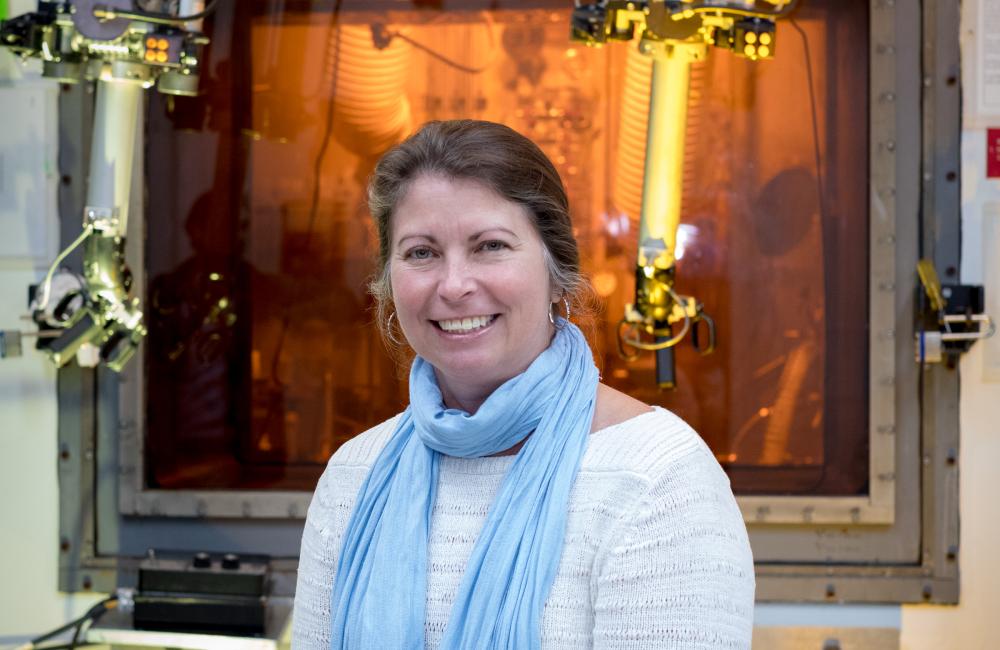Julie Ezold, manager for the californium-252 program at ORNL.
Men with prostate cancer that has spread to their bones can get some relief from a radioactive isotope of radium.
Radium-223, marketed by Bayer as Xofigo, attacks cancerous growths in bones, helping to reduce painful fractures and potentially extending a sufferer’s life.
This valuable treatment owes its effectiveness to two characteristics of radium-223. First, the element radium is chemically similar to calcium, so radium introduced into the body goes straight to the site of growing bone—in this case a growing cancer. Second, the isotope radium-223 emits alpha radiation, which gives off a lot of energy over a very short distance—in this case, a diameter of about a ten-thousandth of a meter, or about 10 cells. As a result, it is largely able to kill cancer cells while leaving other cells unharmed.
The treatment has been approved in the United States since 2013 and, as of 2018, its radioactive essence comes from ORNL’s High Flux Isotope Reactor.
ORNL is a major source of isotopes, providing more than 300 for use in medicine, research, industry and space exploration. Many are or can be produced at lab facilities such as HFIR, the Radiochemical Engineering Development Center and the Enriched Stable Isotope Prototype Plant.
“The isotopes provide capabilities that don’t exist without them,” explained Kevin Hart, manager of ORNL’s isotopes program. “In some cases, we are making isotopes that don’t exist in nature—they would not be there unless we made them.”
What is an isotope?
Elements and isotopes are determined by the number of particles in an atom’s nucleus. The element itself is defined by the number of positively charged protons, so that an atom with one proton is hydrogen, one with six protons is carbon, one with 92 is uranium, and so on. Scientists have identified or created 118 elements, from hydrogen up to oganesson, which has 118 protons.
The isotope, on the other hand, is determined by the number of uncharged neutrons in the nucleus. While all carbon atoms have six protons, they can have anywhere from two to 16 neutrons. If they have eight neutrons, for instance, they are carbon-14 (the total number of protons plus neutrons) and can be used for carbon dating.
There are two primary ways ORNL creates isotopes, depending on whether they are radioactive or stable. For radioactive isotopes, HFIR creates new elements and isotopes by bombarding a target material with neutrons to increase the number of both protons and neutrons in the nucleus.
HFIR is supported by the nearby Radiochemical Engineering Development Center. Facilities at the center, including research laboratories, heavily shielded hot cells and glove boxes, are able both to create new targets for HFIR and to harvest newly created isotopes from targets that come out of the reactor.
For stable isotopes, facilities at the Enriched Stable Isotope Prototype Plant, or ESIPP, separate the different isotopes already present in a material, thereby enriching—or increasing the concentration of—a desired isotope.
The two types of isotope—radioactive and stable—go through very different production processes.
“The radioisotopes require controls like hot cells and glove boxes and lots of containment and highly regulated quantities and packaging,” Hart said. “On the other hand, I can have a bottle of stable isotopes right on my bench top, because there's no decay particles, there's no hazards other than the chemical hazard of whatever formulation the chemical takes—so it would be like any other chemical that we might have here at the lab.”
Making isotopes with neutrons
The creation of isotopes at HFIR involves two processes in the nucleus, explained Julie Ezold, manager for the californium-252 program at ORNL.
The first is neutron capture. HFIR is called “high flux” for a reason: The reactor shoots as many as 2 million billion neutrons each second through a space smaller than the face of a dime. On occasion, one of those neutrons is absorbed by an atom’s nucleus, changing the isotope.
The second process is called “beta decay.” In it, one of the neutrons becomes a proton—changing the element—and the atom spits out an electron and an antineutrino.
To produce californium, for instance, you start with targets made of curium, which has 96 protons and anywhere from 148 to 152 neutrons (curium-244 to curium-248). As they are bombarded, the nuclei slowly take on neutrons.
Unfortunately, most immediately split apart. In fact, 90 percent of nuclei that transform from curium-245 to -246 are lost through this process, known as fission. The nuclei that don’t split apart gradually move through the transmutation process by adding neutrons until they become curium-249.
Curium-249 has a half-life of one hour, transforming into berkelium, which has 97 protons. The process continues until the berkelium transforms into californium, with 98 protons. Then you add neutrons until you get to your goal, californium-252.
Californium-252 is a neutron emitter with a variety of uses. It is used to start up nuclear reactors and is very useful for analyzing anything from coal and minerals to nuclear fuel rods. It can also help identify oil in an oil well.
To produce californium, the targets stay in the reactor through four 24-day cycles. The time depends on the characteristics of the isotope and the number of neutrons a nucleus needs to absorb. Other processes can be longer or shorter; nickel-62 is very resistant to neutron capture, so those targets are left in the reactor for nearly two years to add one neutron to enough nuclei, transforming them to nickel-63, which is valuable for detecting explosives.
HFIR is not used exclusively for isotope production, Ezold noted. In fact, its most prominent use is in cutting-edge neutron scattering research—the use of neutrons to probe the atomic behavior of material and biological systems. Even so, isotope production at the reactor is very important.
“The ‘I’ in HFIR has always been for isotopes,” Ezold said, “Having these facilities, both the reactor and the hot cell facilities, is unique in the world.”
Separations at ESIPP
Most of the American inventory of stable isotopes was enriched in calutrons at Oak Ridge’s Y-12 nuclear weapons plant. The calutrons were specialized mass spectrometers built during World War II to enrich uranium for nuclear weapons, and while most were decommissioned after the war, from eight to 16 were kept in production until 1998 to enrich other isotopes.
To restart American isotope production, DOE agreed in 2009 to build a new facility at ORNL. The prototype electromagnetic isotope separator—or EMIS—was commissioned in 2011. At the time it had about 10 percent of the output of a calutron, but upgrades completed in 2016 made it equivalent to a calutron in output.
The process used by the EMIS relies on the fact that each isotope of an element has a different mass.
First, the element is converted into a gas that is then ionized. Because ions are electrically charged, a stream of them bends as it passes through a magnetic field, but not all the ions bend by the same amount. The isotopes have different masses, and the lighter ones change direction more than the heavier ones.
The result is multiple beams, each containing a single isotope pointed at a collection pocket lined with graphite.
To date, the biggest achievement for the EMIS was production of 350 milligrams of ruthenium-96 for a physics experiment at Brookhaven National Laboratory. That project earned the ORNL team a DOE Secretary's Honor Award.
The EMIS is very efficient at separating isotopes, but it can make only a small amount in any given year. As a result, ORNL has designed a separate technology using gas centrifuges to enrich higher volumes of stable isotopes.
“The main thing to understand is that the electromagnetic isotope separator, the EMIS, is a high enrichment-per-pass technique, but slow, and small throughput,” Hart explained.
The centrifuges—which went through a pilot production run in late 2018—also rely on the fact that different isotopes have different masses. A gas is sent past a spinning rotor, which again changes the direction of the ions based on the mass of the isotope, with heavier atoms moving to the wall and lighter ones staying closer to the center. Unlike in the EMIS, however, the result is two streams—with one made up primarily of the heaviest isotopes— instead of a separate stream for each isotope. As a result, the process involves sending the gas through a series of centrifuges— known as a cascade—to enrich the isotope incrementally.
The centrifuges are especially useful for producing large amounts of an isotope—kilograms, say, rather than grams. One highly promising isotope is xenon-129; when the isotope is inhaled by a patient, it allows an MRI to visualize the air spaces in a person’s lung. In this case, the xenon would be replacing the isotope helium-3, which is in increasingly short supply.
The EMIS and centrifuges will guarantee a domestic source of stable isotopes into the future, Hart said.
“One of the drivers is to ensure that researchers in the United States have access to a domestic source of enriched stable isotopes, because foreign manufacturers may or may not be producing isotopes the researchers need,” he said.



